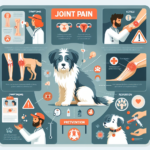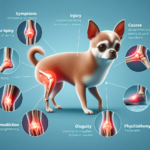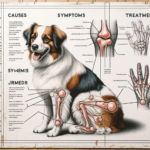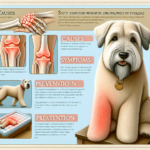Beagle Joint Pain: Causes, Symptoms, Prevention, and Treatment
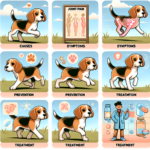
Introduction
Beagles are a beloved breed known for their friendly disposition, keen sense of smell, and boundless energy. Originating from England, Beagles were primarily bred for hunting small game, particularly rabbits. Their compact size, combined with their excellent tracking abilities, made them ideal hunting companions. Today, Beagles are cherished family pets and are also employed in various roles, including detection work due to their acute olfactory senses.
While Beagles are generally healthy dogs, they are prone to certain health issues, including epilepsy, hypothyroidism, and various eye conditions. One of the most significant concerns for Beagle owners is joint pain, which can severely impact the quality of life for these active dogs.
Joint health is crucial for Beagles due to their high energy levels and active lifestyle. Ensuring that their joints remain healthy can help prevent pain and mobility issues, allowing them to enjoy a full and active life.
Breed-Specific Joint Pain Risks
Genetic Predisposition
Beagles, like many other breeds, have a genetic predisposition to certain joint-related issues. Hip dysplasia, a condition where the hip joint doesn’t fit properly into the hip socket, is relatively common in Beagles. This can lead to arthritis and significant pain over time. Elbow dysplasia, although less common, can also affect Beagles, causing similar issues in the front limbs.
Age-Related Risks
As Beagles age, the risk of developing joint pain increases. Arthritis is a common age-related condition that affects many older Beagles. Typically, signs of arthritis may begin to appear when a Beagle reaches middle age, around 6-8 years old. However, this can vary depending on the individual dog’s genetics and lifestyle.
Activity Level and Joint Stress
Beagles are known for their high energy levels and love for physical activity. Whether they are running, playing, or following a scent trail, their joints are constantly in use. While regular exercise is essential for their overall health, excessive or high-impact activities can put additional stress on their joints, potentially leading to pain and injury.
Common Symptoms of Joint Pain in Beagles
General Symptoms
- Limping: One of the most noticeable signs of joint pain is limping or favoring one leg over another.
- Stiffness: Beagles may show stiffness, especially after resting or sleeping.
- Reluctance to Move: A Beagle in pain may be hesitant to jump, climb stairs, or engage in activities they once enjoyed.
- Swelling: In some cases, the affected joint may appear swollen or warm to the touch.
- Behavioral Changes: Pain can lead to changes in behavior, such as irritability or decreased interest in play.
Breed-Specific Symptoms
In Beagles, joint pain may also manifest as a reluctance to follow scent trails or engage in their usual sniffing activities. Given their natural inclination to explore with their nose, a noticeable decrease in this behavior can be a red flag.
When to Consult a Vet
If you observe any of the above symptoms in your Beagle, it is essential to consult a veterinarian. Early diagnosis and intervention can significantly improve the prognosis and quality of life for your dog. Persistent limping, noticeable pain, or any sudden changes in behavior should prompt an immediate veterinary visit.
Preventive Measures for Joint Health
Exercise Recommendations
Regular, moderate exercise is crucial for maintaining joint health in Beagles. Activities such as walking, swimming, and controlled play sessions are excellent choices. Avoid high-impact activities like jumping or running on hard surfaces, which can exacerbate joint stress.
Dietary Suggestions
A balanced diet rich in essential nutrients can support joint health. Consider incorporating foods or supplements that contain glucosamine, chondroitin, and omega-3 fatty acids. These nutrients help maintain cartilage health and reduce inflammation. Always consult your veterinarian before adding supplements to your dog’s diet.
Weight Management
Maintaining a healthy weight is vital for reducing joint stress. Beagles are prone to obesity, which can exacerbate joint issues. Ensure your Beagle receives a balanced diet and regular exercise to keep their weight in check. Your veterinarian can provide specific guidelines based on your dog’s age, size, and activity level.
Early Screening and Monitoring
Regular veterinary check-ups are essential for early detection of joint issues. For Beagles, consider screening for hip and elbow dysplasia, especially if you plan to breed your dog. Early diagnosis allows for timely intervention, which can significantly improve outcomes.
Treatment Options for Joint Pain
Non-Surgical Treatments
Non-surgical treatments are often the first line of defense against joint pain. These may include:
- Medications: Anti-inflammatory drugs and pain relievers can help manage symptoms.
- Physical Therapy: Specialized exercises and therapies can improve joint function and reduce pain.
- Lifestyle Adjustments: Modifying your Beagle’s activity level and environment can help manage pain.
Surgical Options
If non-surgical treatments are ineffective, surgical intervention may be necessary. Common surgical options for Beagles include:
- Hip Replacement: This procedure involves replacing the damaged hip joint with an artificial one.
- Arthroscopy: A minimally invasive surgery used to diagnose and treat joint issues.
- Osteotomy: This surgery involves cutting and realigning bones to improve joint function.
Alternative Therapies
Alternative therapies can complement traditional treatments and provide additional relief. These may include:
- Acupuncture: This ancient practice can help reduce pain and inflammation.
- Hydrotherapy: Water-based exercises can improve joint mobility without putting stress on the joints.
- Massage: Regular massages can help alleviate muscle tension and improve circulation.
Lifestyle and Management Tips
Daily Care Routine
A consistent daily care routine can help manage joint pain in Beagles. This may include:
- Regular, low-impact exercise such as walking or swimming.
- A balanced diet with joint-supporting supplements.
- Administering prescribed medications and supplements as directed by your veterinarian.
- Regular veterinary check-ups to monitor joint health.
Modifying the Home Environment
Making your home more comfortable for a Beagle with joint pain can significantly improve their quality of life. Consider the following modifications:
- Install ramps to help your dog navigate stairs or get onto furniture.
- Provide orthopedic beds to support their joints while resting.
- Ensure food and water bowls are at a comfortable height to reduce strain.
Long-Term Management
Long-term management of joint pain involves a combination of regular veterinary care, appropriate exercise, and a supportive home environment. Consistency is key to keeping your Beagle active and happy despite joint pain.
FAQs About Beagles and Joint Pain
What are the early signs of joint pain in Beagles?
Early signs of joint pain in Beagles include limping, stiffness, reluctance to move, and behavioral changes such as irritability or decreased interest in play.
Can joint pain in Beagles be prevented?
While it may not be entirely preventable, joint pain can be managed and minimized through regular exercise, a balanced diet, weight management, and early screening for joint issues.
Are there specific exercises that are better for Beagles with joint pain?
Low-impact exercises such as walking and swimming are ideal for Beagles with joint pain. These activities help maintain mobility without putting excessive stress on the joints.
What dietary supplements can help with joint health in Beagles?
Supplements containing glucosamine, chondroitin, and omega-3 fatty acids can support joint health. Always consult your veterinarian before adding supplements to your dog’s diet.
When should I consider surgery for my Beagle’s joint pain?
Surgery should be considered if non-surgical treatments are ineffective and your Beagle’s quality of life is significantly impacted. Consult your veterinarian to discuss the best surgical options for your dog.
Conclusion
Joint pain is a common issue that can significantly impact the quality of life for Beagles. By understanding the causes, symptoms, and preventive measures, owners can take proactive steps to ensure their Beagle’s joint health. Regular veterinary care, appropriate exercise, a balanced diet, and a supportive home environment are crucial for managing and alleviating joint pain. Always consult your veterinarian for personalized advice and treatment options to keep your Beagle happy and active.

